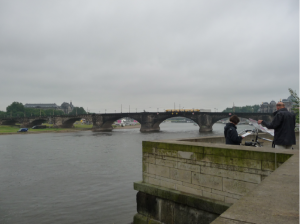 Dresden, a city of 220,000 in the eastern part of Germany, was the target of Allied firebombing in World War II that largely destroyed the city. The wonderful skyline of towers built by the Saxon kings was restored and the downtown area is vibrant. While the eastern part of Germany has suffered from emigration to other regions, Dresden has been growing modestly.
Dresden, a city of 220,000 in the eastern part of Germany, was the target of Allied firebombing in World War II that largely destroyed the city. The wonderful skyline of towers built by the Saxon kings was restored and the downtown area is vibrant. While the eastern part of Germany has suffered from emigration to other regions, Dresden has been growing modestly.
The City is bisected by the Elbe River and has a number of tributaries that flow into it. In 2002, Dresden saw a major flood that inundated the city center, including the central railway station. Over 1 billion Euros in damage was inflicted by the floods and some lives were lost. The flooding was the result of the Elbe River overtopping its banks, rising groundwater, and the Weisseritz River defying its re-direction and flowing in its historic route. The 2002 flood is at the front of City officials’ minds as they develop responses to climate change.
Dresden has a small climate protection office formed in 2010 and headed by Ina Helzig. The office focuses on climate mitigation initiatives. Dresden’s goal is to reduce greenhouse gas emissions by 40% below 2010 levels by 2030. The City sees their climate and sustainability program as part of their economic development strategy.
Work on adaptation has been centered in a regional initiative called REGKLAM that is funded by the federal government. The adaptation program is at the stage of assessing Dresden’s vulnerabilities in order to develop their strategy. But they have already taken action to prevent a repeat of the 2002 flood. The City’s strategy includes preventing additional development in floodplains, monitoring weather conditions, raising flood retention walls by about 1 meter, creating a system of temporary flood retention barriers to protect the city center, modifying the combined sewer system to store more water and reduce the frequency of sewage overflows to the Elbe, and lowering groundwater levels under key buildings. An underground retention facility was constructed at a central pumping station to hold 35,000 cubic meters of storm flows. The City has also installed additional gates in the combined sewer conduit system to shut down the pipes and use them for storage. Dresden believes the improved system will help them minimize the flooding effects of climate change.
One other climate-related strategy that Dresden, and some other German cities, employs is to protect air flow channels coming down from of the surrounding mountains. Most of the land within the city boundaries is open space. There are valleys that slope down to the Elbe River that bring cooler air to the Elbe and into the city. Land use changes and development that would reduce this effect are restricted. While this wasn’t done as an adaptation measure, I think this strategy will help Dresden cope with rising temperatures. This approach has not been taken in any American cities as far as I know. But it would complement other efforts to reduce the urban heat island effect.
